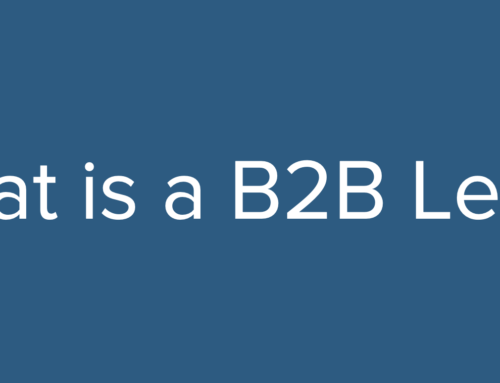As websites have evolved, I am still surprised to find many B2B websites are basically all about the company and what they do or what they offer. That may sound strange to you as a CEO. After all, isn’t the purpose of your website to let people know who you are and what they can buy from you? That is true in a way, but it is more nuanced than ever today by the huge advances and usage of search engines and overall user behavior.
As a quick background discussion, just imagine the B2B world before the web. How did potential prospects learn about you and how did your existing customers get information they needed from you?
For prospects, they evaluated the value of your brand and solutions based on advertising, brochures or other materials, and most importantly the value that your sales person offered them in terms of connecting how your products addressed their pain points and solution needs. Your sales team members (either outside or inside) were the real catalyst of building trust, engaging prospects in exploring solutions, and bringing the buyer to the point in their journey where they made a decision.
For your existing customers, the engagement came through support. They called in for support, dealt directly with service team members in person, took training courses, and of course, continued to interact with your sales person as they checked in on them to keep them happy.
Those two groups, prospects and customers, still want information from you today, but you now have to employ new tactics to engage them effectively using your web site. So, within this context, let’s discuss how prospects and customers find your B2B website and what content you must offer each — which leads us to your B2B website purpose (or purposes).
Your B2B website purpose – customer support and up-sell engagement
Let’s start with the easy one, the purpose of your website for existing customers. It’s in your best interest to try and deliver certain types of support to your customers on your website, before they tie up valuable support resources with email or phone contact. With that said, you should ensure that you purposefully organize and populate content on your website to provide two critical opportunities for your customers.
Self-serve content for common support issues – Providing high quality support content on your site not only makes customers very happy and productive, but, as just mentioned, also allows you to staff efficiently and focus on business growth. Consider providing support content like FAQs (frequently asked questions) as a searchable knowledge base, recorded training videos or webinar style screen shares, cross-reference tools for product replacement (depending on what you sell), and certainly quick access to find who they can contact for support (maybe chat support as well as email or phone options).
You should make the support area of your site very clear in navigation and may have to consider the value of public content vs. private content (where customers must login to access) to make sure that prospects can see key public content that may help build trust with them as they explore you as a provider.
Finally, show off your positive support statistics and customer satisfaction ratings. Make your infographics (98% first-call resolution, etc.) visible so that customers and prospects can hear that story and trust you even more.
Content that promotes new “up-sell” or “cross-sell” opportunities – The second opportunity exist because an existing customer is always a good prospect, right? They trust you already so this is low-hanging fruit for selling upgrades, add-on products, or cross selling into other parts of their business.
With that in mind, remember that this content is different than your home page or general prospect content. Don’t make the mistake of lumping that together. The message you will use in marketing to this group is different and should be uniquely developed. Use your support opportunities, your regular customer transactional emails (billing, support follow-up, etc.), your customer newsletter, and any area on your site frequented by customers to promote links and/or content to new product information, education, and calls to action that will engage them with sales again.
Added insight – Don’t forget to motivate your support staff (inside support or field support personnel) to identify leads for up-sell, cross-sell and pass those along to sales. I work with one company whose field service group were responsible for identifying existing customer leads that resulted in $24M in sales in the past year.
Your B2B website purpose – engaging prospects
The second significant purpose of a B2B website, and the one that likely deserves your attention first, is to engage prospects. I know this is a given. I know that you are acutely aware of this purpose. My goal is to share key nuances of this that I believe are essential for you as a CEO to know to ask the right questions and set the right expectations for your marketing team.
Not one but many landing pages – The first nuance is about how prospects “land” on your website. I deliberately refer to prospects “landing” on your website because in web lingo, when someone clicks on a link to your site or your URL, they “land” on your site. The page they land on is called the “landing page.” Why is this important?
It is important because it is vital for you and your marketing team to view your website not as a single landing page site (your home page), but as an opportunity for many customized and purposeful landing pages that you can utilize across targeted marketing tactics and custom messaging.
Your home page is a primary landing page. It is vital that your home page speak directly to prospects about their pain points and needs and how you can solve their problems and deliver value. Your home page should not be a catalog of what you sell, the story of your history, or other things that I would call “we” things. In other words, your home page should be about “you” (your customer – each segment you are wanting to engage).
However, beyond your home page, the real value is ensuring your site has a collection of customized landing pages you utilize for targeted campaigns. Some of these landing pages may be existing pages on your site (those one might find using your menus) but other pages may only be used as a landing page for a tactic and not available through menus.
Say you run a paid search campaign that specifically targets buyers that are concerned about cyber security at their power plant. You are a power equipment and power management software provider. You would not want to direct them from that search to your home page. Sure, you may have something about cyber security on your home page along with everything else, or a menu item for cyber security, but why make the prospect work to find what they were specifically searching for? They won’t do that. If they don’t see the direct topic that relates to what they were searching for in the first 10-15 seconds, they will leave.
The answer then is to create a specific (or use a specific page) landing page that is all about cyber security. Just imagine if you were searching for “how do I protect my utility plant from hackers.” What would you want to see when you clicked on the link?
When you view your website as a collection of potential landing pages for those searching the web, your focus shifts from just organizing your menus to ensuring that you are producing the pages and content that will directly support your targeted campaigns.
SEO is not optional – Consider the statistic that “Organic web search clicks outnumber paid nearly 12 to 1” (“10 search behavior statistics you need to know!” –business2community.com). Organic web search clicks occur when someone searching the web finds some of your content as a result of that search (on the first page normally). This is not paid search. They are not finding an ad you have bought for that keyword. This means that for businesses as a whole, more people (12 to 1) are actually finding links to existing content on their web sites.
However, to take advantage of this, your B2B website has to be optimized for search engines to find and like your content. This is where SEO (Search Engine Optimization) and professional SEO and content consultants bring you value. SEO itself, the act of coding the appropriate meta data (keywords) into your HTML code or through your CMS (content management system – like WordPress) is not that hard. So, many times your marketing team will say that they can do that. However, the real value is evaluating the types and value of content your site is providing, along with that coding, to effectively promote your content to those search engines. For that, I recommend you at least start with a professional consultant to develop a solid plan and ongoing action items.
Finally, here are just a few brief tips I want to share that you should keep in mind as you lead your team to have the most engaging website possible.
- Don’t let IT own the website. A website is a marketing tool and marketing should be in full control. They will need some technical support from IT or an outside firm but marketing should have the full ability to add, change, delete content without waiting for some IT people (even outside firm) to make that happen. Any site that cannot be maintained by marketing is a failure.
- Pass the “cover your eye” test. Open your website home page and cover up the logo. Now, if you pretend you are a prospect reading your site, could this content exist on ALL of your competitor sites? In other words, can you quickly identify the unique value you bring to prospects that differentiates you from others? If not, then you are just any site in your market.
- Google paid search is likely an “ante” in today’s search world. Google search sends 10x more traffic than the next leading referrer (“10 search behavior statistics you need to know!” -business2community.com). With that kind of traffic delivery, you should at least consider paid search until you can firmly establish your own organic search results rankings. Paid search is akin to print advertising from a few decades ago. It is the branding in the marketplace. Having said that, make sure your paid search uses custom landing pages for each unique ad campaign and not just links to your home page.
- Answer the questions your buyers are asking. As you develop your market segmentations, buyer personas, needs and messaging, make sure your team comes up with a list of the top questions (maybe five or so) that your ideal buyer is asking when they are looking for solutions. Now, check that your home page (and other key places on your site) are answering those questions.
Your B2B website purpose – eCommerce
The last key purpose of some B2B websites is to actually provide the ability for prospects and customers to purchase products. That is a topic I am not going to delve into here but I did want to mention it. This is certainly a significant purpose and you would likely want to ensure you have outside professional consulting help in planning and executing on the content, technology, privacy/security issues required to offer this on your site.
B2B website investment
Your website can deliver great value and should get the right attention in terms of your investment to ensure it fulfills these three (or two if you don’t have eCommerce) purposes. This requires investments in:
- strong market segmentation and audience segmentation
- value proposition / messaging content
- purposeful organization based on messaging and audience
- ongoing content management and SEO
- ongoing new content postings to keep feeding search engines
- strong analysis of web analytics for continuous improvement
When prospects find you in their research and engage with you, or when your customers are delighted on the level of support they can get on your site, it’s all worth it.






